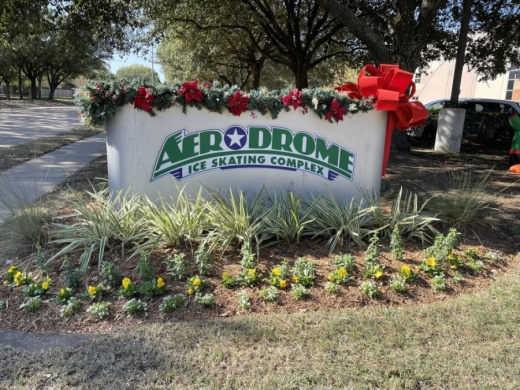Power went out for the skating rink around the same time it did for many Houston residents affected by Uri—around 2 a.m. the morning of Feb. 15—and remained out for 38 hours or so, General Manager T.C. Lewis said. Power outages for skating rinks can be disastrous under normal circumstances, he said. Rinks in Houston rely year-round on compressors to keep ice frozen. When power goes out for an extended period of time, the sheets of ice will melt, causing potentially hundreds of thousands of dollars in damage.
"We literally can be a swimming pool at that point," Lewis said.
However, because the outside temperatures were so cold during the power outage, the ice remained in tact, Lewis said. But there was another problem: A frozen pipe within the facility's sprinkler system burst, and the leak flooded the compressor room, causing electrical and motor damage to each of the Aerodrome's two compressors.
A local electrician made an emergency visit to address the electric issues, but the two motors had to be pulled out and sent off for repairs, a process that would take weeks, Lewis said. In the meantime, the weather was starting to warm up again.
With a potential disaster approaching, Lewis said a tip from a HVAC and technology company and a stroke of "dumb luck" helped prevent the rink from losing its ice and having to close its doors for a much more intensive repair process. A worker with Johnson Controls, who supplies the motors for the Aerodrome's compressor, also happened to do repairs on compressors at the Sugar Land Ice and Sports Center.
Coincidentally, the Sugar Land rink recently removed a motor from one of its machines, and the repair technician suggested Lewis give the Sugar Land rink a call to see if he could borrow it temporarily while his motors were being repaired. The Sugar Land rink agreed, and Johnson Controls drove to Sugar Land, disassembled the 600-pound compressor and brought the motor back to the Aerodrome. They were able to get a compressor back up and running, Lewis said.
"You literally never, ever have an extra motor sitting around," Lewis said. "They don’t grow on trees. You don’t go to Home Depot. They are specifically built. To me, it's remarkable they loaned it to us, and it's just dumb luck that they had one."
While some ice was lost, enough was saved the Aerodrome—which maintains a client base of more than 1,000 people, including traveling and in-house hockey leagues, figure skaters and free skaters—was able to reopen and operate as normal as of 3 p.m. Feb. 22, Lewis said.
"Our customers show up at 5 a.m. and leave at midnight," he said. "There are a lot of people that would’ve been impacted."
Without the motor, Lewis said there is no doubt the ice would have melted, and the repairs could have cost as much as $500,000 and taken three months to complete. On top of fixing the burst pipe and the motors, the repair process would have involved releveling the sand underneath the ice, slowly building the ice back up, and repainting all the red and blue lines on the rink, he said.
He said he was unsure what the costs would have ended up being for the labor and motor repairs, but said they would most likely be in the tens of thousands of dollars instead.
The Aerodrome's second compressor, which normally serves as a backup in case the first one fails, will remain offline for another two weeks or so as the motor is repaired. Until then, Lewis said he will still feel some stress. But he said he overall feels lucky to have averted a much worse situation and is grateful for the help he received along the way.
"It was good work by good partners, our staff and friends in the rink community," he said. "Everything kind of fell into place, and we are thankful."





